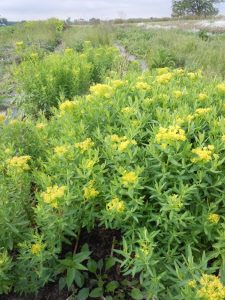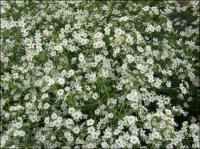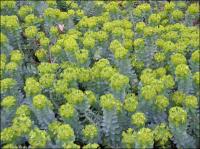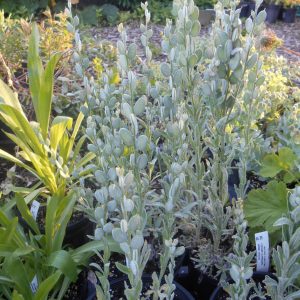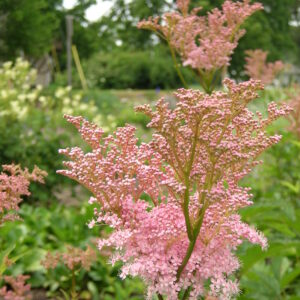Perennials & Biennials
Showing 177–184 of 485 results
-
Eupatorium purpureum syn. Eutrochium purpureum Sweet Joe Pye weed Z 4-9
July – September the top of each stem branches into several smaller stems. In turn a bundle of tubes grows out of each of these smaller stems and in turn more, thinner flowers grow out of each tube, forming a dusty rose dome a foot or more across.
July – September the top of each stem branches into several smaller stems. In turn a bundle of tubes grows out of each of these smaller stems and in turn more, thinner flowers grow out of each tube, forming a dusty rose dome a foot or more across.
Size: 5- 7’ x 3-4’
Care: Sun to part shade in moist, alkaline soil
Native: Eastern U.S., Wisconsin native
Wildlife Value: attracts bees and butterflies Monarch. Foliage feeds moth caterpillars.Named “Joe Pye weed” after an Indian medicine man who used the plant in New England to cure typhus. Meskwaki Indian men “nibbled (Joe Pye weed) when speaking to women when they are in the wooing mood.” This had the power of “fetching” women. Good luck when gambling for the Potawatomi. Oneidas used it to cure fever. Mahuna Indians of So. California made an infusion of the root to cure colds and coughs. Colonists used the plant to cure dropsy, gravel, gout, and rheumatism. Collected by Rev. John Banister who moved to colonial Virginia in 1678. A gunman mistakenly shot and killed him while he collected plants. Offered for sale in Bartram Garden’s 1783 Broadside, America’s 1st plant catalog.
-
Eupatorium sessilifolium Upland boneset Z 4-8b
Showy, flat to dome-topped, platter-like, numerous small-flower clusters of white bloom July to September
Showy, flat to dome-topped, platter-like, numerous small-flower clusters of white bloom July to September
Size: 3-5’ x 12-24”
Care: Shade to part shade in moist well-drained to dry soil (one of few dry shade flowers)
Native: Maine to Minnesota south to Kansas, east to Georgia. Wisconsin native (endangered, threatened or of special concern in 8 states – Indiana, Iowa, Maine, Michigan, Minnesota, New Hampshire, Vermont & Wisconsin
Wildlife Value: nectar attracts bees and butterflies. Foliage is food for their caterpillars. Deer & rabbit resistant.English botanist Rev. John Bannister (1654-1692) collected this in colonial Virginia. He was shot and killed by misadventure while collecting plants. Described by Scottish botanist Robert Morison (1620-1683) in Historis Plantarum Univeralis Oxoniensis pars tertia (vol. 3) 98, published posthumously in 1699.
-
Euphorbia colorata syn. E. collorata Perennial poinsettia
Chartreuse bracts in spring and redish stems and leaves in autumn.
OUT OF STOCK
Chartreuse bracts in spring and redish stems and leaves in autumn.
Size: 12-16 x 12
Care: sun in dry to moist well-drained soilRoot used as purgative according to Gould’s Dictionary of New Medical Terms (1905). Collected on the Mexican Boundary Expedition c. 1850.
-
Euphorbia corollata Flowering spurge Z 4-7
Small white flowers (bracts), like a baby's breath but better, July & August. One of the best prairie natives, but slow to mature.
Small white flowers (bracts), like a baby’s breath but better, July & August. One of the best prairie natives but slow to mature.
Size: 36' x 24" spreading slowly
Care: sun in well-drained to moist well-drained soil. Drought resistant.
Native: Canada to Florida and west through the plains, Wisconsin native
Wildlife Value: deer resistant. Its pollen & nectar feed endangered Karner Blue butterfly as well as other small butterflies, numerous bees, wasps and flies. Several birds eat the seeds.A favorite medicine among native Americans. Cherokee rubbed the plant’s juice on skin to cure cancer. Also used to remedy tooth aches and gonorrhea. Winnebago cut a 2.5” long root to clear stomach and steeped leaves for a baby’s colic. According to Breck (1851), “One of the most elegant species peculiar to the United States.”
-
Euphorbia myrsinites Donkeytail spurge Z 5-8
Chartreuse umbels at stem tips in early spring contrast succulent blue-gray foliage encircling the reclining stem.
Chartreuse umbels at stem tips in early spring contrast succulent blue-gray foliage encircling the reclining stem.
Can not ship to: Colorado.
Size: 4” x 12”
Care: Sun in well-drained soil
Native: Western Asia
Awards: Royal Horticultural Society Award of Merit.Euphorbia was named for Euphorbus, physician of Numibian King Juba, father of Ptolemy (c. 50 B.C. – 20 A.D.) Reputedly Euphorbus used spurge to remedy the King’s enlarged stomach. Euphorbus’s brother was Augustus Caesar’s physician. Myrsinites is a Greek word meaning “resembling myrtle.” This plant described by Swiss botanical scholar Conrad Gesner in his book Horti Germaniae published in 1541.
-
Euphorbia polychroma Cushion spurge syn. Euphorbia epithymoides Z 4-9
May – June a clump of flashy chartreuse bracts frame each flower altogether growing in a dome 12-18" tall and wide on erect, sturdy stems. In fall foliage turns orangey-red.
May – June a clump of flashy chartreuse bracts frame each flower altogether growing in a dome 12-18″ tall and wide on erect, sturdy stems. In fall foliage turns orangey-red.
Size: 16" x 24"
Care: Sun, moist well-drained humusy soil.
Native: Central and Southern Europe
Awards: Royal Horticultural Society Award of Garden Merit.Polychroma means many colors referring to the fact that the foliage changes colors. Named by Swedish botanist Linnaeus 1753.
-
Fibigia clypeata Roman shields Z 5-8
Yellow spring flowers in early summer, followed by small, oval “silver dollars” on erect stems. “What is that?” many customers ask.
Yellow spring flowers in early summer, followed by small, oval “silver dollars” on erect stems. “What is that?” many customers ask.
Size: 18” x 12-15”
Care: sun well-drained soil Self-seeds freely
Native: Southern Europe
Wildlife Value: source of nectar and pollen for bees and other insectsUsed for their ornamental seed pods. Harvest either when 1st form for fuzzy grey-green color or when mature with outer skin removed for translucent, silver shield. In gardens before 1753.
-
Filipendula rubra ‘Venusta’ Queen of the prairie Z 3-9
Extraordinary frothy pink plumes, like cotton candy, blooming in midsummer
Extraordinary frothy pink plumes, like cotton candy, blooming in midsummer
Size: 4-6’ x 4-5'
Care: sun to part shade in moist well-drained to moist soil
Native: US East coast west to MN s to MO and NC, Wisconsin native
Wildlife Value: This creates pollen but not nectar limiting the pollinators to bees and flies (Butterflies and wasps want nectar.).
Awards: Award of Garden Merit from England’s Royal Horticultural Society.Name is Latin filum pendulus meaning hanging by thread referring to threads on the roots of another species.
Wildlife value: This creates pollen but not nectar limiting the pollinators to bees and flies (Butterflies and wasps want nectar.)
Meskwaki Indians used the species for heart ailments and as an aphrodisiac. Although the plant’s name has been changed five times, the species was 1st described in 1768. Robinson, Rhodora, v. 8 pp. 202-205 (1907). “Filipendulina, a New Binomial,” The flowers of this cultivar are darker than the species. Described by German botanist Andreas Voss (1857-1922).



